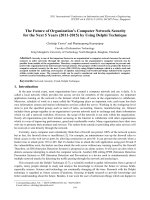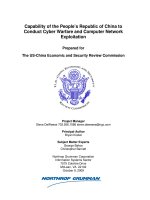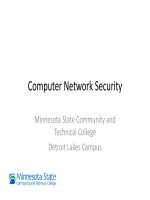computer network lesson
Bạn đang xem bản rút gọn của tài liệu. Xem và tải ngay bản đầy đủ của tài liệu tại đây (1.21 MB, 60 trang )
6.1
6
6
Computer
Computer
Networks
Networks
Foundations of Computer Science Cengage
Learning
6.2
Describe network criteria, physical structures and categories
of networks.
Describe the TCP/IP protocol suite as the network model in
the Internet.
Define the layers in the TCP/IP protocol suite and their
relationship.
Discuss the client-server architecture of the Internet.
Describe the three early applications of the Internet:
Understand the World Wide Web as the most common
application of the Internet and its components.
Distinguish between three Internet document types: static,
dynamic and active.
Objectives
Objectives
After studying this chapter, the student should be able
After studying this chapter, the student should be able
to:
to:
6.3
6-1 INTRODUCTION
6-1 INTRODUCTION
A
A
network
network
is a combination of hardware and software
is a combination of hardware and software
that sends data from one location to another. The
that sends data from one location to another. The
hardware consists of the physical equipment that carries
hardware consists of the physical equipment that carries
signals from one point in the network to another. The
signals from one point in the network to another. The
software consists of instructions that make the services
software consists of instructions that make the services
that we expect from a network possible.
that we expect from a network possible.
6.4
Network criteria
A network must be able to meet a number of criteria. The
most important of these are performance, reliability, and
security.
Performance can be measured in many ways, including transit time
and response time.
Network security issues include protecting data from unauthorized
access, damage and change, and implementing policies and procedures
for recovery from breaches and data losses.
Reliability is measured by the frequency of failure, the time it takes to
recover from a failure, and the network’s robustness in a catastrophe.
6.5
Physical structures
Before discussing networks, we need to define some network
attributes.
Types of Connection: A network consists of two or more devices
connected through links. A link is a communications pathway that
transfers data from one device to another. There are two possible types
of connections: point-to-point and multipoint.
Figure 6.1 Types of connections: point-to-point and multipoint
6.6
The term physical topology refers to the way in which a network is
laid out physically. There are four basic topologies possible: mesh,
star, bus and ring.
Figure 6.2 Four physical topologies
6.7
Categories of networks
Today networks can be divided into three broad categories:
local-area networks (LANs), wide-area networks (WANs)
and metropolitan area networks (MANs).
Figure 6.3 An isolated LAN connecting eight computers to a hub
6.8
Figure 6.4 A point-to-point WAN and a backbone WAN
6.9
An internet
Today, it is very rare to see a network in isolation: networks
are connected to one another. When two or more networks
are connected, they become an internetwork, or an internet
(lowercase “i”).
Figure 6.5 An internet made of WANs, LANs, and routers
6.10
The Internet
The most notable internet is the Internet (uppercase “I”), a
collaboration of hundreds of thousands of interconnected
networks. Private individuals, as well as various
organizations such as government agencies, schools,
research facilities, corporations and libraries in more than
100 countries use the Internet. Millions of people are users.
It is difficult to give an accurate representation of the
Internet, because it is continually changing. Today, most end
users who want an Internet connection use the services of
Internet service providers (ISPs).
6.11
Figure 6.6 Hierarchical organization of the Internet
6.12
6-2 TCP/IP PROTOCOL SUITE
6-2 TCP/IP PROTOCOL SUITE
To divide the services required to perform a task, the
To divide the services required to perform a task, the
Internet has created a set of rules called protocols.
Internet has created a set of rules called protocols.
These allow different local and wide area networks,
These allow different local and wide area networks,
using different technologies, to be connected together
using different technologies, to be connected together
and carry a message from one point to another. The set,
and carry a message from one point to another. The set,
or suite, of protocols that controls the Internet today is
or suite, of protocols that controls the Internet today is
referred to as the
referred to as the
TCP/IP protocol suite
TCP/IP protocol suite
. The
. The
abbreviations (TCP and IP) will become clear as we
abbreviations (TCP and IP) will become clear as we
explain different protocols.
explain different protocols.
6.13
The original TCP/IP protocol suite was defined as having
four layers: host-to-network (or link), internet (network),
transport and application. However, the TCP/IP protocol
suite today is normally considered as a five-layer model, as
shown in Figure 6.7.
Figure 6.7 The TCP/IP protocol suite
6.14
Figure 6.8 shows the layers involved when a message is sent
from device A to device B. As the message travels from A to
B, it may pass through many routers. Routers use only the
first three layers.
Figure 6.8 The interaction between layers in the TCP/IP protocol suite
6.15
6-3 LAYERS
6-3 LAYERS
This section briefly describes the function of each
This section briefly describes the function of each
layer
layer
in the TCP/IP protocol suite. We show how a message
in the TCP/IP protocol suite. We show how a message
travels through the different layers until it reaches the
travels through the different layers until it reaches the
physical layer and is sent by the transmission media.
physical layer and is sent by the transmission media.
6.16
Application layer
The application layer enables a user, whether human or
software, to access the network. It provides support for
services such as electronic mail, remote file access and
transfer, browsing the World Wide Web, and so on.
The application layer is responsible for providing
services to the user.
i
6.17
Client-server architecture
Although there are two architectures (designs) that allow two
application programs, running on two remote computers, to
communicate with each other, client-server architecture is
more common.
Figure 6.9 Communication at the application layer
6.18
Application-layer address
When a client needs to send a request to a server, it needs the
server application-layer address. For example, to identify one
particular site, the client uses a Uniform Resource Locator
(URL). As we will see later, the server application-layer
address is not used for delivery of messages, it only helps the
client to find the actual address of the server computer.
Figure 6.10 Addresses at the application layer
6.19
Transport layer
The transport layer is responsible for process-to-process
delivery of the entire message: logical communication is
created between the transport layer of the client and the
server computer. In other words, although physical
communication is between two physical layers (through
many possible links and routers), the two application layers
consider the transport layer as the agent that takes
responsibility for delivering the messages.
The transport layer is responsible for the logical
delivery of a message between
client and server processes.
i
6.20
Figure 6.11 Communication at the transport layer
6.21
Transport-layer addresses (port numbers)
The server computer may be running several processes at the
same time, for example an FTP server process and an HTTP
server process. When the message arrives at the server, it
must be directed to the correct process. We need another
address for server process identification, called a port
number.
Figure 6.12 Addresses at the transport layer
6.22
Transport-layer protocols
During the life of the TCP/IP protocol suite three transport
layer protocols have been designed: UDP, TCP and SCTP.
The User Datagram Protocol (UDP) is the simplest of all
three protocols. UDP does multiplexing and de-multiplexing
It also does a type of error control by adding a checksum to
the packet.
Transmission Control Protocol (TCP) is a protocol that
supports all the duties of a transport layer. However, it is not
as fast and as efficient as UDP. TCP uses sequence numbers,
acknowledgment numbers and checksums. It also uses
buffers at the sender’s site. This combination of provisions
provides multiplexing, de-multiplexing, flow control,
congestion control and error control.
6.23
Stream Control Transmission Protocol (SCTP) is a new
protocol that is designed for new services expected from the
Internet, such as Internet telephony and video streaming.
This protocol combines the advantages of both UDP and
TCP. Like UDP, it is suitable for real-time transmission of
audio and video, but like TCP, it provides error and flow
control.
6.24
The network layer
The network layer is responsible for the source-to-
destination (computer-to-computer or host-to-host) delivery
of a packet, possibly across multiple networks (links). The
network layer ensures that each packet gets from its point of
origin to its final destination.
The network layer is responsible for the delivery of
individual packets from the source host to the
destination host.
i
6.25
Network-layer addresses
The packet traveling from the client to the server and the
packet returning from the server need a network-layer
address. The server address is provided by the server, as
discussed above, while the client address is known by the
client computer.
Figure 6.13 Addresses at the network layer









